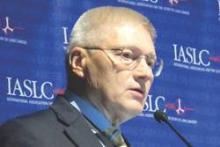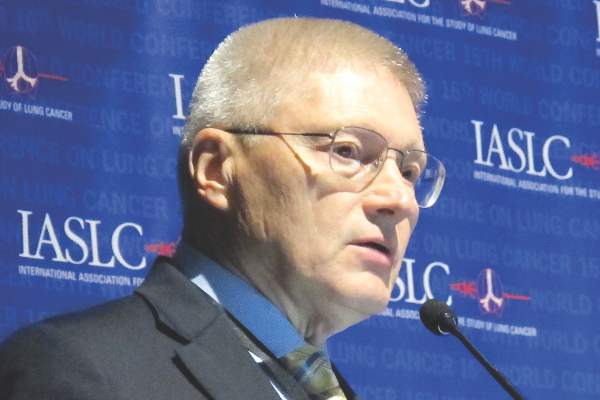User login
DENVER – Anamorelin, an investigational compound that mimics the action of the so-called “hunger hormone” ghrelin, was effective at helping patients with cachexia gain weight, but fell short when it came to improving hand-grip strength, a surrogate for muscle mass, results of two clinical trials showed.
Among patients with advanced non–small cell lung cancer (NSCLC) and cachexia enrolled in two randomized clinical trials, those who took anamorelin daily over 12 weeks gained about 1 kg of lean body mass, compared with patients on placebo, who experienced further losses of lean body mass.
“Weight loss and loss of appetite are dominant symptoms in lung cancer patients, especially advanced lung cancer patients. About 70% experience this problem, and it’s something we hear in the clinic every day: Patients are frustrated and the family’s frustrated trying to get the patient to eat, but he or she can’t do it,” said investigator Dr. Philip Bonomi from Rush University Medical Center in Chicago.
He discussed results of the phase III ROMANA 1 and ROMANA 2 trials at a media briefing here at a world conference on lung cancer sponsored by the International Association for the Study of Lung Cancer.
Cachexia, defined as a loss of 5% or more of body weight over 6 months or a body mass index below 20 kg/m2, is associated with poor clinical outcomes, including worse functional status, decreased quality of life, and shorter survival.
Anamorelin is an orally active selective ghrelin receptor agonist designed to mimic the hunger-inducing and anabolic effects of the natural hormone.
In the independent ROMANA 1 and ROMANA 2 trials, a total of 979 patients with unresectable stage III or IV NSCLC and cachexia were randomly assigned on a 2:1 basis to receive anamorelin 100 mg orally per day or placebo for 12 weeks.
For the coprimary endpoint of change in lean body mass patients assigned to anamorelin in ROMANA 1 (323 patients) had a median gain in lean body mass of 1.1 kg over 12 weeks, compared with a loss of 0.44 kg among 161 patients who received placebo (P less than .001)
In ROMANA 2, the 330 patients assigned to anamorelin gained a median of 0.75 kg, while the 165 assigned to placebo lost a median of 0.96 kg (P less than .001).
But for the other coprimary endpoint of improvement in hand-grip strength, patients in each arm of each trial lost strength over the 12 weeks, and there were no significant between-group differences, Dr. Bonomi said.
For the secondary endpoint of change in anorexia/cachexia domain of the Functional Assessment of Anorexia/Cachexia Therapy (FAACT) questionnaire, patients who received anamorelin in each trial had significantly greater mean change from baseline in scores (4.12 vs. 1.92 for placebo in ROMANA 1; P = .0004: and 3.48 vs. 1.34 in ROMANA 2; P = .0016).
A prespecified exploratory-responder analysis also showed approximately twice as many patients treated with anamorelin maintained or gained lean body mass over the course of the study, compared with controls.
Regarding the failure of the drug to meet one of its primary endpoints, improvement of hand-grip strength as measure of gain in muscle mass, Dr. Bonomi said “Was it the right thing to measure? Many people think probably not, but nevertheless, there was no difference in hand-grip strength.”
He said that future studies should focus on whether therapies for cachexia can help improve patient’s physical functioning and activities of daily living.
DENVER – Anamorelin, an investigational compound that mimics the action of the so-called “hunger hormone” ghrelin, was effective at helping patients with cachexia gain weight, but fell short when it came to improving hand-grip strength, a surrogate for muscle mass, results of two clinical trials showed.
Among patients with advanced non–small cell lung cancer (NSCLC) and cachexia enrolled in two randomized clinical trials, those who took anamorelin daily over 12 weeks gained about 1 kg of lean body mass, compared with patients on placebo, who experienced further losses of lean body mass.
“Weight loss and loss of appetite are dominant symptoms in lung cancer patients, especially advanced lung cancer patients. About 70% experience this problem, and it’s something we hear in the clinic every day: Patients are frustrated and the family’s frustrated trying to get the patient to eat, but he or she can’t do it,” said investigator Dr. Philip Bonomi from Rush University Medical Center in Chicago.
He discussed results of the phase III ROMANA 1 and ROMANA 2 trials at a media briefing here at a world conference on lung cancer sponsored by the International Association for the Study of Lung Cancer.
Cachexia, defined as a loss of 5% or more of body weight over 6 months or a body mass index below 20 kg/m2, is associated with poor clinical outcomes, including worse functional status, decreased quality of life, and shorter survival.
Anamorelin is an orally active selective ghrelin receptor agonist designed to mimic the hunger-inducing and anabolic effects of the natural hormone.
In the independent ROMANA 1 and ROMANA 2 trials, a total of 979 patients with unresectable stage III or IV NSCLC and cachexia were randomly assigned on a 2:1 basis to receive anamorelin 100 mg orally per day or placebo for 12 weeks.
For the coprimary endpoint of change in lean body mass patients assigned to anamorelin in ROMANA 1 (323 patients) had a median gain in lean body mass of 1.1 kg over 12 weeks, compared with a loss of 0.44 kg among 161 patients who received placebo (P less than .001)
In ROMANA 2, the 330 patients assigned to anamorelin gained a median of 0.75 kg, while the 165 assigned to placebo lost a median of 0.96 kg (P less than .001).
But for the other coprimary endpoint of improvement in hand-grip strength, patients in each arm of each trial lost strength over the 12 weeks, and there were no significant between-group differences, Dr. Bonomi said.
For the secondary endpoint of change in anorexia/cachexia domain of the Functional Assessment of Anorexia/Cachexia Therapy (FAACT) questionnaire, patients who received anamorelin in each trial had significantly greater mean change from baseline in scores (4.12 vs. 1.92 for placebo in ROMANA 1; P = .0004: and 3.48 vs. 1.34 in ROMANA 2; P = .0016).
A prespecified exploratory-responder analysis also showed approximately twice as many patients treated with anamorelin maintained or gained lean body mass over the course of the study, compared with controls.
Regarding the failure of the drug to meet one of its primary endpoints, improvement of hand-grip strength as measure of gain in muscle mass, Dr. Bonomi said “Was it the right thing to measure? Many people think probably not, but nevertheless, there was no difference in hand-grip strength.”
He said that future studies should focus on whether therapies for cachexia can help improve patient’s physical functioning and activities of daily living.
DENVER – Anamorelin, an investigational compound that mimics the action of the so-called “hunger hormone” ghrelin, was effective at helping patients with cachexia gain weight, but fell short when it came to improving hand-grip strength, a surrogate for muscle mass, results of two clinical trials showed.
Among patients with advanced non–small cell lung cancer (NSCLC) and cachexia enrolled in two randomized clinical trials, those who took anamorelin daily over 12 weeks gained about 1 kg of lean body mass, compared with patients on placebo, who experienced further losses of lean body mass.
“Weight loss and loss of appetite are dominant symptoms in lung cancer patients, especially advanced lung cancer patients. About 70% experience this problem, and it’s something we hear in the clinic every day: Patients are frustrated and the family’s frustrated trying to get the patient to eat, but he or she can’t do it,” said investigator Dr. Philip Bonomi from Rush University Medical Center in Chicago.
He discussed results of the phase III ROMANA 1 and ROMANA 2 trials at a media briefing here at a world conference on lung cancer sponsored by the International Association for the Study of Lung Cancer.
Cachexia, defined as a loss of 5% or more of body weight over 6 months or a body mass index below 20 kg/m2, is associated with poor clinical outcomes, including worse functional status, decreased quality of life, and shorter survival.
Anamorelin is an orally active selective ghrelin receptor agonist designed to mimic the hunger-inducing and anabolic effects of the natural hormone.
In the independent ROMANA 1 and ROMANA 2 trials, a total of 979 patients with unresectable stage III or IV NSCLC and cachexia were randomly assigned on a 2:1 basis to receive anamorelin 100 mg orally per day or placebo for 12 weeks.
For the coprimary endpoint of change in lean body mass patients assigned to anamorelin in ROMANA 1 (323 patients) had a median gain in lean body mass of 1.1 kg over 12 weeks, compared with a loss of 0.44 kg among 161 patients who received placebo (P less than .001)
In ROMANA 2, the 330 patients assigned to anamorelin gained a median of 0.75 kg, while the 165 assigned to placebo lost a median of 0.96 kg (P less than .001).
But for the other coprimary endpoint of improvement in hand-grip strength, patients in each arm of each trial lost strength over the 12 weeks, and there were no significant between-group differences, Dr. Bonomi said.
For the secondary endpoint of change in anorexia/cachexia domain of the Functional Assessment of Anorexia/Cachexia Therapy (FAACT) questionnaire, patients who received anamorelin in each trial had significantly greater mean change from baseline in scores (4.12 vs. 1.92 for placebo in ROMANA 1; P = .0004: and 3.48 vs. 1.34 in ROMANA 2; P = .0016).
A prespecified exploratory-responder analysis also showed approximately twice as many patients treated with anamorelin maintained or gained lean body mass over the course of the study, compared with controls.
Regarding the failure of the drug to meet one of its primary endpoints, improvement of hand-grip strength as measure of gain in muscle mass, Dr. Bonomi said “Was it the right thing to measure? Many people think probably not, but nevertheless, there was no difference in hand-grip strength.”
He said that future studies should focus on whether therapies for cachexia can help improve patient’s physical functioning and activities of daily living.
AT THE WORLD CONGRESS ON LUNG CANCER
Key clinical point: The ghrelin receptor agonist anamorelin helped patients with cancer cachexia gain lean body mass.
Major finding: Patients cachexia on anamorelin in two studies gained lean body mass over 12 weeks, while patients on placebo lost mass.
Data source: Two independent randomized phase III trials enrolling a total of 979 patients with advanced non–small cell lung cancer and cachexia.
Disclosures: The studies were sponsored by Helsinn Therapeutics. Dr. Bonomi serves on the advisory board to the company and has received honoraria from it.

